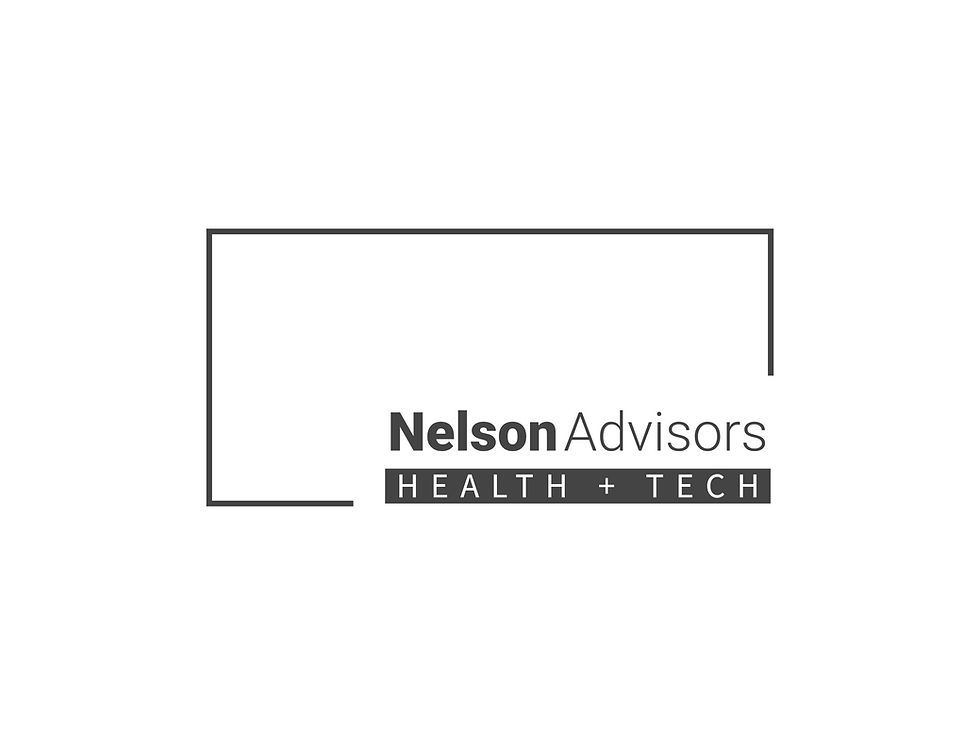Intrinsic Value v Market Value in today's HealthTech M&A market
- Lloyd Price
- Feb 1
- 9 min read
Updated: Feb 9

Exec Summary:
The HealthTech M&A market is recovering in 2025 and the dance between intrinsic value and market value is more intricate than ever. Here's how it plays out in this dynamic sector:
Factors Driving HealthTech M&A
Digital Health Revolution: The pandemic accelerated the adoption of telehealth, remote patient monitoring, and other digital health solutions, making HealthTech companies attractive targets.
Data is King: Companies with valuable health data, AI-driven analytics, or platforms that improve healthcare efficiency are highly sought after.
Consolidation and Competition: Established healthcare players are looking to acquire innovative HealthTech companies to expand their offerings, gain a competitive edge, or enter new markets.
Investment Appetite: Venture capital and private equity firms are pouring money into HealthTech, fuelling growth and creating potential acquisition targets.
Intrinsic Value in HealthTech M&A
Beyond Financials: While traditional financial metrics are important, intrinsic value assessment in HealthTech M&A often places a greater emphasis on:
Technology and Innovation: The uniqueness and potential of the technology, its intellectual property, and the strength of the development team.
Data Assets: The quality, quantity, and accessibility of health data, and the company's ability to leverage it for insights and improved outcomes.
User Base and Engagement: The size and engagement of the user base, especially for direct-to-consumer HealthTech companies, as this indicates market traction and future potential.
Regulatory Landscape: The regulatory environment and potential reimbursement pathways for the company's products or services, which can significantly impact future revenue streams.
Challenges in Valuation:
Early-Stage Companies: Many HealthTech companies are still in early stages, making it challenging to project future cash flows and assess long-term potential.
Disruptive Technologies: Valuing companies with disruptive technologies can be difficult, as their impact on the market may be uncertain.
Regulatory Uncertainty: Changes in healthcare regulations can create uncertainty and impact valuations.
Market Value in HealthTech M&A
High Valuations: The HealthTech sector has seen high valuations in recent years, driven by investor enthusiasm and the potential for rapid growth.
Strategic Premiums: Acquirers are often willing to pay significant premiums over market value to acquire companies with strategic fit, innovative technologies, or access to valuable data.
Competitive Bidding: In a competitive M&A market, bidding wars can drive up valuations beyond what might be considered a purely financial intrinsic value.
Key Considerations
Synergies are Crucial: The potential for synergies between the acquirer and the target company is a major driver of valuations in HealthTech M&A. Synergies can include:
Technology Integration: Combining complementary technologies to create a more comprehensive solution.
Data Sharing and Analytics: Leveraging data from both companies to improve insights and personalise healthcare.
Market Access: Expanding market reach through the acquirer's existing network and customer base.
Due Diligence is Critical: Thorough due diligence is essential to validate the target company's technology, assess its data assets, and evaluate its regulatory compliance.
Long-Term Vision: HealthTech M&A often involves a long-term vision, as it can take time to integrate technologies, realise synergies, and achieve the desired financial and strategic outcomes.
In today's HealthTech M&A market, intrinsic value remains a crucial foundation, but it's often intertwined with strategic considerations, the value of data assets, and the potential for disruption.
Acquirers are willing to pay premiums for companies that can accelerate their digital health strategies, provide access to valuable data, or offer innovative solutions that improve healthcare delivery.
Nelson Advisors
Nelson Advisors work with Healthcare Technology Founders, Owners and Investors to assess whether they should 'Build, Buy, Partner or Sell' in order to maximise shareholder value https://nelsonadvisors.co.uk/
Healthcare Technology Thought Leadership from Nelson Advisors – Market Insights, Analysis & Predictions. Visit https://www.healthcare.digital
Buy Side, Sell Side, Growth & Strategy services for HealthTech Founders, Owners and Investors. Email lloyd@nelsonadvisors.co.uk
Nelson Advisors Healthcare Technology Newsletter > Mergers, Acquisitions, Growth, Strategy, Insights & Predictions. Subscribe Today! https://lnkd.in/e5hTp_xb
#HealthTech #DigitalHealth #HealthIT #NelsonAdvisors #Mergers #Acquisitions #Growth #Strategy #Innovation #NHS #VentureCapital #PrivateEquity #UK #Europe

Intrinsic Value in today's HealthTech M&A market
The HealthTech M&A market is currently experiencing a period of robust activity, with a significant increase in both the number and value of deals. This surge is driven by several factors, including the growing demand for innovative healthcare solutions, the increasing adoption of digital health technologies, and the influx of capital into the sector.
Key Trends:
Increased Deal Value: The total exit value of HealthTech companies has nearly doubled in recent years, with a significant rise in deals worth over $1 billion. This indicates a strong appetite for mature and high-growth HealthTech companies.
Strategic Acquisitions: Major players in the healthcare industry, such as pharmaceutical companies, medical device manufacturers, and healthcare providers, are actively acquiring HealthTech companies to expand their portfolios, gain access to new technologies, and enhance their competitive position.
Private Equity Involvement: Private equity firms are increasingly investing in HealthTech, driving scaled M&A activity and providing growth capital to promising companies.
Focus on Innovation: Companies with unique technologies, strong intellectual property, and a proven track record of innovation are highly sought after in the M&A market.
Geographic Distribution: While the United States remains the dominant force in HealthTech M&A, there is growing activity in other regions, particularly Europe and Asia.
Valuation Considerations:
In this dynamic market, determining the intrinsic value of a HealthTech company requires a comprehensive assessment of various factors, including:
Financial Performance: Revenue growth, profitability, and cash flow are key indicators of a company's financial health and potential for future success.
Technology and Innovation: The uniqueness and defensibility of a company's technology, as well as its ability to innovate and develop new solutions, are crucial for long-term value creation.
Market Position: A company's market share, competitive landscape, and growth potential in its target market are important considerations.
Regulatory Environment: The regulatory landscape in which a company operates, including any approvals or certifications required, can significantly impact its value.
Team and Leadership: The experience and expertise of the management team, as well as their ability to execute on the company's vision, are essential for success.
Challenges and Opportunities:
While the HealthTech M&A market presents significant opportunities, there are also challenges to consider:
Valuation Complexity: Accurately valuing HealthTech companies can be complex due to the unique nature of their technologies, business models, and regulatory environments.
Integration Risks: Integrating acquired HealthTech companies into existing organizations can be challenging, requiring careful planning and execution.
Competition: The HealthTech sector is highly competitive, and companies must differentiate themselves to attract acquisition interest.
The HealthTech M&A market is currently thriving, driven by strong demand for innovative healthcare solutions and increasing investment in the sector. Determining the intrinsic value of a HealthTech company requires a thorough analysis of its financial performance, technology, market position, and other relevant factors. While challenges exist, the opportunities for value creation in this dynamic market are significant.
Market Value in today's HealthTech M&A market
While intrinsic value focuses on the inherent worth of a company, market value reflects what buyers are actually willing to pay for it in the current M&A environment.
Here's a breakdown of how market value is determined in today's HealthTech M&A landscape:
Factors Driving Market Value:
Strategic Fit: This is paramount. How well does the target company align with the acquirer's strategic goals? Does it fill a gap in their portfolio, provide access to new markets or technologies, or enhance their competitive advantage? A strong strategic fit can significantly inflate the market value.
Competitive Landscape: The level of competition for a particular asset plays a major role. If multiple bidders are interested, the price is likely to be driven up. Conversely, if there's limited interest, the market value may be closer to the intrinsic value.
Market Dynamics: Broader trends in the healthcare and technology sectors influence valuations. Factors like investor sentiment, availability of funding, and regulatory changes can all impact what buyers are willing to pay.
Deal Structure: The specifics of the deal, such as whether it's an all-cash offer, a stock-for-stock transaction, or a combination, can affect the perceived value.
Synergies: Potential cost savings or revenue increases that can be achieved by combining the target company with the acquirer's existing business are a key driver of market value. The greater the synergies, the higher the potential price.
Valuation Metrics and Multiples:
While intrinsic value calculations provide a baseline, market value is often assessed using a range of metrics and multiples, including:
Revenue Multiples: This is a common metric in HealthTech, especially for companies with high growth potential but limited profitability. The multiple applied will vary based on factors like growth rate, market position, and technology.
EBITDA Multiples: For more mature companies with established earnings, EBITDA multiples are often used to assess market value.
Deal Premiums: The difference between the final acquisition price and the target company's stock price (if publicly traded) or its most recent valuation (if private) reflects the premium paid by the acquirer. This premium can be significant in competitive situations.
Current Market Trends:
High Valuations: Due to the strong demand for innovative HealthTech solutions, market values are generally high, often exceeding intrinsic values.
Focus on Growth: Buyers are willing to pay a premium for companies with strong revenue growth and a clear path to profitability.
Strategic Acquisitions: As mentioned earlier, strategic acquisitions are driving a significant portion of the market value, as acquirers are willing to pay more for assets that align with their long-term goals.
It's crucial to remember that market value is dynamic and can fluctuate based on a variety of factors. It's not a fixed number but rather a reflection of what buyers are willing to pay at a specific point in time.
In conclusion, while intrinsic value provides a foundation for understanding a HealthTech company's worth, market value is the ultimate determinant of the final deal price in an M&A transaction. It's influenced by a complex interplay of strategic fit, competition, market dynamics, and potential synergies.

Why market value is more important than intrinsic value in today's HealthTech M&A market
While intrinsic value is a crucial foundation, market value often takes precedence in determining the final outcome of a deal. Here's why:
M&A is a Market-Driven Process: Ultimately, M&A transactions are driven by supply and demand. Even if a company has a strong intrinsic value, if there aren't buyers willing to pay for it, that value is irrelevant in the context of a sale. Market value reflects the actual price buyers are willing to pay in that specific moment, regardless of underlying fundamentals.
Strategic Imperatives Trump Pure Valuation: Acquirers often have strategic goals that go beyond pure financial returns. They might need a specific technology to fill a gap in their offerings, expand into a new market, or gain a competitive edge. In these cases, they may be willing to pay a premium over the intrinsic value to achieve those strategic objectives.
Competition Creates Price Pressure: When multiple bidders are interested in a HealthTech company, a competitive bidding process ensues. This can significantly drive up the market value, often far exceeding the intrinsic value. The fear of losing out on a valuable asset can push acquirers to offer higher prices.
Market Sentiment and Momentum: The overall mood of the market, investor confidence, and recent successful deals can all influence market value. A hot market can lead to inflated valuations, even if those valuations aren't fully justified by the underlying fundamentals.
Synergies are Key: The potential for synergies – cost savings, revenue increases, or other benefits – plays a huge role in determining market value. Acquirers are willing to pay more for a company that offers significant synergies with their existing business, as this can increase the overall value of the combined entity.
Think of it like this:
Intrinsic value: Is like the blueprint of a house, outlining its size, materials, and potential.
Market value: Is what someone is willing to pay for that house right now, considering its location, curb appeal, and current real estate market conditions.
Even if a house has a great blueprint (intrinsic value), its market value will ultimately depend on what buyers are willing to pay in the current market.
In the HealthTech M&A context:
A company might have groundbreaking technology and strong financials (intrinsic value), but its market value will be determined by factors like:
How well it fits with potential acquirers' strategies
The level of competition for the asset
The overall market conditions for HealthTech deals
The potential synergies it offers
Key Takeaway:
While intrinsic value is important for understanding the fundamental worth of a HealthTech company, market value is the ultimate driver of deal prices in today's M&A market. It's a reflection of what buyers are willing to pay, influenced by strategic fit, competition, market dynamics, and potential synergies.
Nelson Advisors
Nelson Advisors work with Healthcare Technology Founders, Owners and Investors to assess whether they should 'Build, Buy, Partner or Sell' in order to maximise shareholder value https://nelsonadvisors.co.uk/
Healthcare Technology Thought Leadership from Nelson Advisors – Market Insights, Analysis & Predictions. Visit https://www.healthcare.digital
Buy Side, Sell Side, Growth & Strategy services for HealthTech Founders, Owners and Investors. Email lloyd@nelsonadvisors.co.uk
Nelson Advisors Healthcare Technology Newsletter > Mergers, Acquisitions, Growth, Strategy, Insights & Predictions. Subscribe Today! https://lnkd.in/e5hTp_xb
#HealthTech #DigitalHealth #HealthIT #NelsonAdvisors #Mergers #Acquisitions #Growth #Strategy #Innovation #NHS #VentureCapital #PrivateEquity #UK #Europe


















































Comments